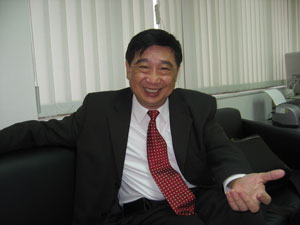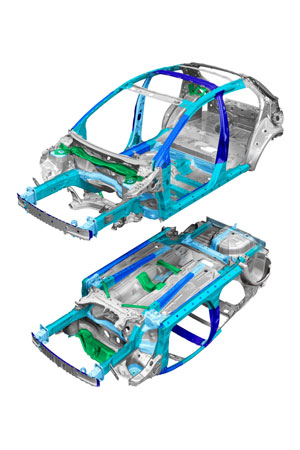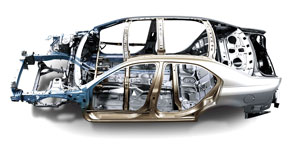Reducing Weight as Important as Battery Tech in Electric Vehicles: MIRDC V.P.
2009/04/20 | By Quincy LiangWhile oil crisis may come and go, the relevance of electric vehicles as green means of mass transport will not wane. In fact there remains a group of die-hards who continue to work on more viable, popular electric vehicles, with the Tesla and the recently-reported rapid recharge lithium battery developed by MIT students that could become a reality in couple of years being two examples that help push electric cars toward mainstream.
Dr. Paul Chung, vice president of the Metal Industries R&D Centre (MIRDC) and an internationally renowned expert in machinery, metal, and transportation vehicle fields, brings attention to a CENS (China Economics News Service) reporter, during a recent interview, issues that don't seem to be questioned, as they should be, in developmental efforts surrounding electric vehicles.
The MIRDC is a non-profit organization established 45 years ago to engage in R&D of leading technologies related to metal industries in Taiwan. Officially funded, the MIRDC's achievements have helped the progress of many involved in basic metal, metal products, machinery, electrical, appliances, vehicular equipment, precision instrument sectors.

True Cost Per-Mile
Chung asks a question almost all electric (including hybrid)-vehicle makers intentionally ignore, with consumers also overlooking or turning a blind eye: what is the true cost per- mile of an electric vehicle?
"Electric vehicle has been the hottest issue in transportation equipment fields for years, and will be a necessary choice in the future as increasingly more products are commercialized with improved battery performance and propulsion-system management," Chung confirms, and responds to the above question, "But the public should realize, and vehicle makers should talk as they walk it, that the true cost per-mile of an electric vehicle is often five- to six-folds that of a gasoline-engine counterpart because the cost should take into account the battery cost rather than only the recharging cost. Such battery cost is significant for the onboard battery life is greatly shortened due to full discharging and recharging cycles, changes in ambient temperatures etc. In short, compared to conventional gasoline-engine vehicles, electric cars are still too expensive or cost-ineffective."
Weighty Issue
Having opened the true-cost-per-mile can of worms, Chung continues, albeit from a different perspective, by broaching one of the oldest, critical and yet often-slighted criteria in vehicle building: weight. Colin Chapman, pioneer of featherweight Lotuses, and other makers of well-known fuel-efficient cars as the Beetle, Mini, 2CV, Datsun 510, Twingo, Fiat 128, BMW 2002, Smart etc. can attest to the truism that fuel efficiency varies proportionally with a vehicle's curb weight. In other words, the lighter the vehicle the better for per-mile cost.
"The typical mid-sized sedan today, such as a Toyota Camry, weighs about 1,500kgs or 3,400 lbs.," Chung says, "but frequently people drive such a vehicle to carry only about 200 kg (two to three passengers). Is that cost-effective or environment-friendly enough? I think most will say no without having better solutions under current conditions. But imagine a light electric vehicle (LEV) weighing about 500 kgs designed safe and light enough to do the same commuting job."
"The MIRDC is thinking about and trying to improve a vehicle building criteria from another perspective, though not new but increasingly important," the vice president says. "We believe cutting vehicular weight is as important as battery development for electric vehicles."
Weight management has long been one of the key targets for automakers, with such issue taking on extra weight today when developing electric vehicles is being prioritized, and especially when perhaps as much as half of an LEV's mass may be due to batteries.
Reduced vehicular weight has an added advantage-enhanced safety in collisions-for less weight means less mass is driven upon impact, Chung says. The most important safety structure in a vehicle is its space frame containing passengers. "Safety is maximized via good design rather than using heavy metal beams or sheets," Chung says, "space-frame with impact-absorption design plus advanced manufacturing techniques can both upgrade vehicle safety while reduce weight."

As Important as Battery Technology
"Although battery technology is the core of electric-vehicle development," Chung says, "we think, in fact, minimizing vehicular weight is equally important because battery-performance upgrading takes much longer time and R&D cost than reducing weight via design and manufacturing techniques. In addition, lighter vehicular weight means longer cruise range and lower user cost, which are key factors for higher popularity of electric vehicles."
"Cost per-mile or kilometer of electric vehicles has been a neglected key issue, but the deciding factor of the penetration rate of such transports," Chung says. "With per-mile cost clearly reduced with lighter vehicles, you know the importance of minimizing vehicular weight today."
Chung offers some examples for weight-cutting, such as the hybrid option of using aluminum and steel to make front cradles by the semi-solid hybrid material casting technique, which can save up to 30% of the original cradle weight but at only 10% higher material cost, with savings in tooling cost also; using magnesium front-end structure to reduce parts number by 60% and half the weight by utilizing extrusion and casting techniques; adopting high-strength steel (HSS) and tubular space frame with hydro-forming and casting methods; or the hybrid structure concept (already used on the Audi A2 sub-compact) with a combination of extruded sheet metal and tubular beams to save tooling investments.
Opportunities Abound
"We are encouraged that there are still many opportunities for Taiwanese companies to develop weight-cutting production and design techniques as well as assembled vehicles and parts, because the overall transportation-vehicle market is being reshuffled as it turns to electric," Chung says. "In the initial stage of electric-vehicle development, the market is relatively small to allow competitive newcomers to come onboard, while production volumes are modest relative to conventional car-making requiring huge investments. Taiwan has already gained a solid foothold in the LEV market, having built electric bicycles and scooters, and more and more players on the island are expected to join the game."
Taiwan's core competitiveness in the electric-vehicle business lies in its ability to build products fully meeting customers' requirements and needs, and the island's makers have their work cut out, being already internationally famous for filling small-volume, large-variety orders, strong R&D, innovation and satellite suppliers of key parts as battery, motor, control unit etc., Chung says,
MIRDC's Role
MIRDC, one of the most important centers for automotive-technique and technology R&D in Taiwan and a member of the Taiwan Automotive Research Consortium (TARC), has been aggressively working on vehicular weight-reduction techniques for a long time in design and manufacturing. To access the most advanced weight-cutting production techniques and know-how, the center began closely cooperating with Magna International Inc., a top-four auto-parts supplier worldwide of body, chassis and engine parts.
"Due to the lack of a homegrown automotive industry and prolonged technical domination by foreign automakers, no local company has been involved in automotive chassis development before," Chung says. "We recognized such weakness and have been actively trying to remedy the situation with the government's subsidization."
The MIRDC's vigorous efforts in the past few years have paid off: the center is responsible for the development of key chassis parts for the Luxgen, the fully-homegrown Taiwanese auto brand built by the domestic Yulon Group. The center imports the latest techniques, develops localized production capability, and transfers R&D achievements to private companies interested in becoming first-tier parts makers.

Helping to Build OEMs
In addition to developing weight-cutting techniques, Chung says, the center is also trying to help local auto-parts makers as they aim to become OE (original equipment) parts supplier to international automakers, because tapping such markets is often a long and, in many cases, difficult road fraught with uncertainties.
"Taiwan is the best place globally to realize cross-field system integration," the vice president says, meaning a local supplier can easily build a device integrated with electronics, optoelectronics, computer, micro-electromechanical systems etc.
The vice president suggest local auto-parts makers focus on the aftermarket parts segment for upgraded items, naming examples as the AFS (Adaptive Front-lighting System), auto-dampening system, auto-tilting seats (seats that tilt automatically to compensate for the road inclines according to electronic or video sensors) etc.
Chung also believes in the potential across the Taiwan Strait: "The huge auto-parts aftermarket in China offers endless opportunities to technology-oriented and innovative parts makers in Taiwan, because, compared to other western markets, this emerging market still welcomes newcomers with competitive products."

